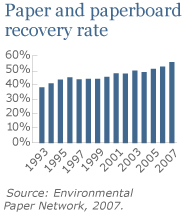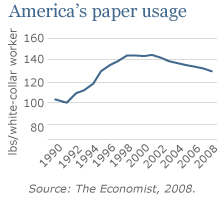Read more articles from the "It’s Easy Being Green" series
"Think of the hundreds of times a day we touch paper — newspapers, cereal boxes, toilet paper, water bottle labels, parking tickets, streams of catalogs and junk mail, money, tissues, books, shopping bags, receipts, napkins, printer and copier paper at home and work, magazines, to-go food packaging. This list could fill a paperback."
— Environmental Paper Network

Have you seen the paper elephant standing in the middle of your office? How about the one in your living room?

When you think of all the things that we use paper for here in the United States, it should come as no surprise that it accounts for 25 percent of all the stuff that goes into our landfills. But as easy as paper is to recycle, how could it cause such a problem? Here are a few charts showing just how big a problem (700 pounds per capita, to be precise) America’s paper consumption has become.

The United States’ paper recovery rate is at nearly 60 percent. Even so, according to the Environmental Paper Network, while over 80 percent of America has access to paper recycling, a large quantity of paper is still getting thrown away. According to EPN, if the United States cut office paper use by just 10 percent, it would prevent the emission of 1.6 million tons of greenhouse gases—the equivalent of taking 280,000 cars off the road.

We can do more to cut back on our paper consumption and increase our paper recovery. The pie chart to the right illustrates paper and paperboard’s dominating presence among the municipal solid waste stream.

America has gotten into the habit of clicking the "print" button when most of the time an email or .pdf would suffice. The days of printed memos have come and gone, but we are using the same amount of office paper as we were in 1994.
Here are a few ways you can help cut back on paper waste without even getting out of your seat:

▪ Print to .pdf. Do you really need a hard copy this time around? Think twice before you click that "print" button.
▪ Eliminate junk mail. Green Dimes offers a service that stops 90 percent of junk mail from filling up your mailbox. Even better, the service is completely free. If you subscribe to the premium subscription for $20 per year, Green Dimes plants five trees on your behalf and gives you additional benefits. Check it out at www.greendimes.com.
▪ Educate your coworkers and classmates. Paperrecycles.org offers a number of educational tools on the whys and hows of recycling paper for the classroom or household. You can also customize a recycling poster to put up around the office. Find out more at www.paperrecycles.org.

▪ Go paperless. Many banks today offer a completely digital online banking system, including an online archive of your bank statements that you can access at anytime. It’s free, safe, easy and, best of all, saves paper!
Read more articles from the "It’s Easy Being Green" series